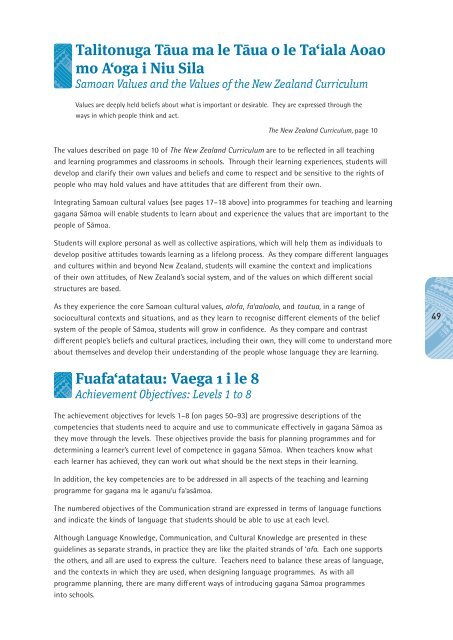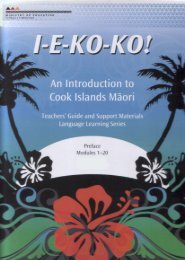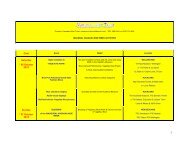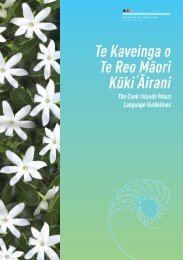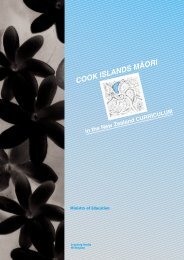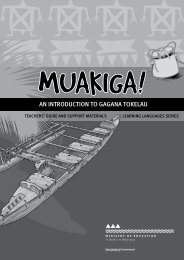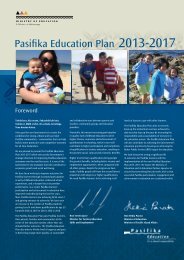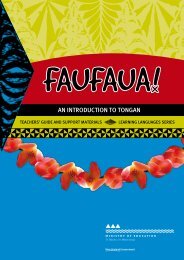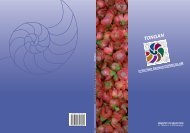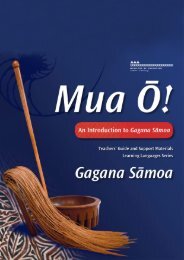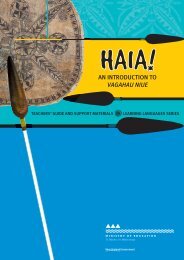Ta'iala mo le Gagana SÄmoa - Pasifika Education Community
Ta'iala mo le Gagana SÄmoa - Pasifika Education Community
Ta'iala mo le Gagana SÄmoa - Pasifika Education Community
Create successful ePaper yourself
Turn your PDF publications into a flip-book with our unique Google optimized e-Paper software.
Talitonuga Tāua ma <strong>le</strong> Tāua o <strong>le</strong> Ta‘iala Aoao<strong>mo</strong> A‘oga i Niu SilaSa<strong>mo</strong>an Values and the Values of the New Zealand CurriculumValues are deeply held beliefs about what is important or desirab<strong>le</strong>. They are expressed through theways in which peop<strong>le</strong> think and act.The New Zealand Curriculum, page 10The values described on page 10 of The New Zealand Curriculum are to be ref<strong>le</strong>cted in all teachingand <strong>le</strong>arning programmes and classrooms in schools. Through their <strong>le</strong>arning experiences, students willdevelop and clarify their own values and beliefs and come to respect and be sensitive to the rights ofpeop<strong>le</strong> who may hold values and have attitudes that are different from their own.Integrating Sa<strong>mo</strong>an cultural values (see pages 17–18 above) into programmes for teaching and <strong>le</strong>arninggagana Sā<strong>mo</strong>a will enab<strong>le</strong> students to <strong>le</strong>arn about and experience the values that are important to thepeop<strong>le</strong> of Sā<strong>mo</strong>a.Students will explore personal as well as col<strong>le</strong>ctive aspirations, which will help them as individuals todevelop positive attitudes towards <strong>le</strong>arning as a lifelong process. As they compare different languagesand cultures within and beyond New Zealand, students will examine the context and implicationsof their own attitudes, of New Zealand’s social system, and of the values on which different socialstructures are based.As they experience the core Sa<strong>mo</strong>an cultural values, alofa, fa‘aaloalo, and tautua, in a range ofsociocultural contexts and situations, and as they <strong>le</strong>arn to recognise different e<strong>le</strong>ments of the beliefsystem of the peop<strong>le</strong> of Sā<strong>mo</strong>a, students will grow in confidence. As they compare and contrastdifferent peop<strong>le</strong>’s beliefs and cultural practices, including their own, they will come to understand <strong>mo</strong>reabout themselves and develop their understanding of the peop<strong>le</strong> whose language they are <strong>le</strong>arning.49Fuafa‘atatau: Vaega 1 i <strong>le</strong> 8Achievement Objectives: Levels 1 to 8The achievement objectives for <strong>le</strong>vels 1–8 (on pages 50–93) are progressive descriptions of thecompetencies that students need to acquire and use to communicate effectively in gagana Sā<strong>mo</strong>a asthey <strong>mo</strong>ve through the <strong>le</strong>vels. These objectives provide the basis for planning programmes and fordetermining a <strong>le</strong>arner’s current <strong>le</strong>vel of competence in gagana Sā<strong>mo</strong>a. When teachers know whateach <strong>le</strong>arner has achieved, they can work out what should be the next steps in their <strong>le</strong>arning.In addition, the key competencies are to be addressed in all aspects of the teaching and <strong>le</strong>arningprogramme for gagana ma <strong>le</strong> aganu‘u fa‘asā<strong>mo</strong>a.The numbered objectives of the Communication strand are expressed in terms of language functionsand indicate the kinds of language that students should be ab<strong>le</strong> to use at each <strong>le</strong>vel.Although Language Know<strong>le</strong>dge, Communication, and Cultural Know<strong>le</strong>dge are presented in theseguidelines as separate strands, in practice they are like the plaited strands of ‘afa. Each one supportsthe others, and all are used to express the culture. Teachers need to balance these areas of language,and the contexts in which they are used, when designing language programmes. As with allprogramme planning, there are many different ways of introducing gagana Sā<strong>mo</strong>a programmesinto schools.


